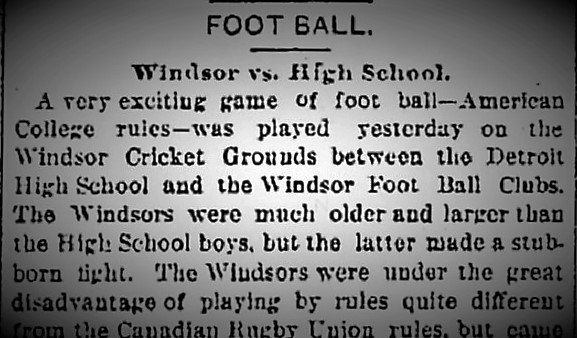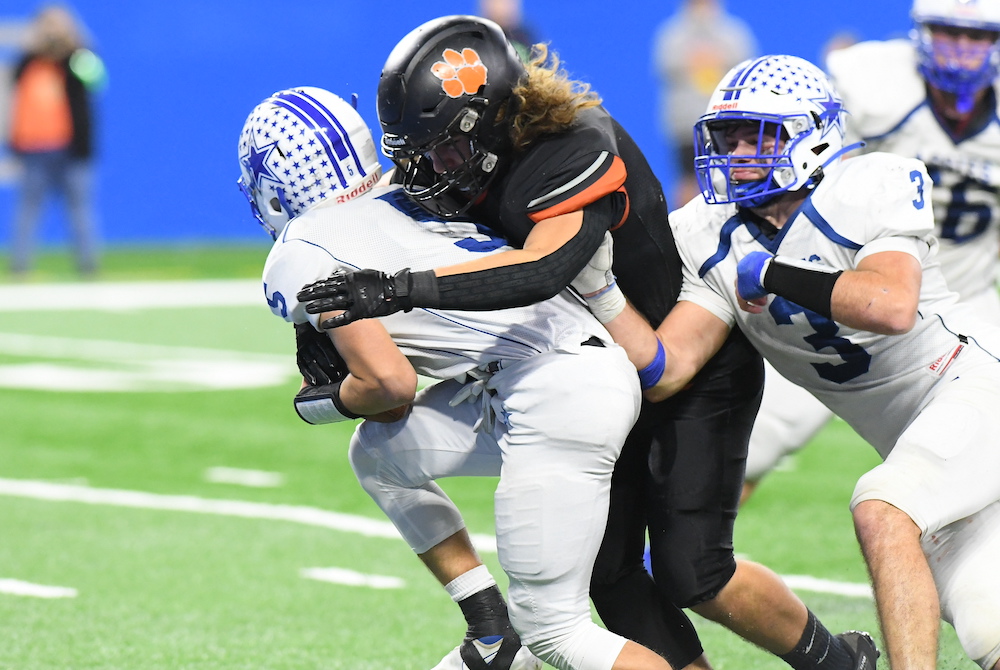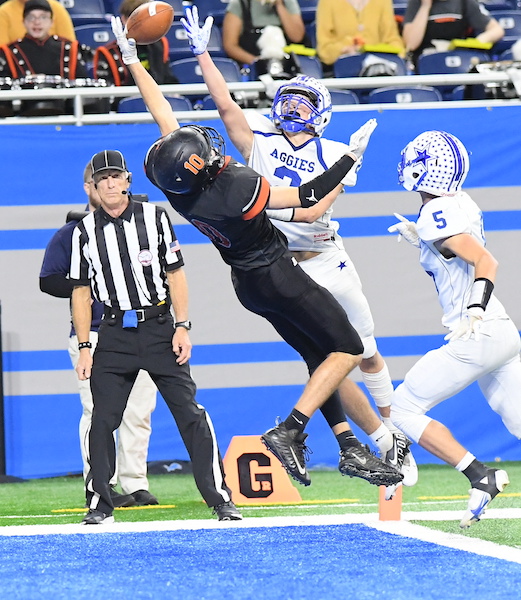
Football Kicks Off Again, 129 Years Later
August 25, 2017
By Ron Pesch
Special for Second Half
Buried in the text on the fourth page of the Saturday, October 27, 1888, Detroit Free Press is a single, concise sentence bearing a minimum amount of detail.
“The Windsor foot ball team will play the Detroit High School team this afternoon at 3.”
To date, this is the earliest account of a Michigan high school playing the game of “foot ball.”
The following day’s paper provides only a few more details. The game was played on the Windsor Cricket Grounds. Despite the great disadvantage of playing under “American Football rules … quite different from the Canadian Rugby Union rules …” the “older and larger” Windsors won the contest, 12-6. Rosters for each squad were provided.
 Under American rules of the time, a touchdown was worth four points, with a conversion kick following a touchdown worth two additional points. At the time, a field goal counted for five points and a safety was worth two. The teams, however, may have agreed to a different scoring system before the contest.
Under American rules of the time, a touchdown was worth four points, with a conversion kick following a touchdown worth two additional points. At the time, a field goal counted for five points and a safety was worth two. The teams, however, may have agreed to a different scoring system before the contest.
Was this the first football game for a Michigan high school? That’s unlikely, but it is certainly among the earliest published accounts involving a prep game in the state.
It’s a fair assumption that foot ball, or some version of the game, was being played in neighborhoods before that time, at least based on the following statement found in the Jackson Citizen Patriot, dated June 18, 1867. Only days before, Dorrance & Goodwin’s, a store on Main Street in Jackson, had placed advertisements in the newspaper’s classifieds noting the pending arrival of this new product.
“Foot Ball – The pastime was inaugurated on our streets yesterday. Three or four balls were kept in motion all day on Main street alone. It affords no little amusement to the little boys, and is certainly a healthy exercise for the larger ones. It’s all right as long as no windows are broken or horses scared. Both calamities were barely escaped scores of times during the day.”
Rutgers and Princeton are credited with playing the first college football game in 1869. A decade later, in 1879, the University of Michigan established a football team.
Detroit High School played a number of games in 1888, besides the Windsor match, including a contest with the Tappen School from the Corktown area of Detroit. Played at the Detroit Athletic Club grounds on the afternoon of Thursday November 15, a final score was not mentioned in the following day’s Free Press.
For those unfamiliar with the sport, an account of the University of Michigan versus Detroit Athletic Club contest that appeared in the November 18 Free Press served as a fine introduction to the game, and the determination behind securing “possession of a leather-covered foot ball.”
“It was very interesting to see one speedy young man, after a desperate struggle in which the spectators fully expected to see him lose an arm or a leg, get away from his captors and start like a deer, with eight or ten of the opposite side in full pursuit. He is overtaken and the leader of the pursuing party springs upon the back of the man with the inflated trophy, bearing him to the ground with a dull thud … It is also an inspiring sight to see a fleet-footed player seize the ball and run at full speed in the direction of the goal of his opponents. Then a wing-footed opponent cuts across to intercept him, makes a flying leap, grasps the fugitive around the neck or waist and both go to grass with a suddenness and velocity that transforms them into human wheels …
 “While one unaccustomed to foot ball will naturally be startled by some of the acrobatic feats, still it is impossible to watch the game for any length of time without a tingling of the blood and holding of the breath. It is most intensely exciting, continuous in action and replete with fine points of play.
“While one unaccustomed to foot ball will naturally be startled by some of the acrobatic feats, still it is impossible to watch the game for any length of time without a tingling of the blood and holding of the breath. It is most intensely exciting, continuous in action and replete with fine points of play.
“It may be explained that the goals in a foot ball game are set at a distance of 330 feet from each other. The goal is made by placing two pieces of scantling twenty feet long upright in the ground, eighteen and one-half feet apart. Another piece runs midway horizontally between the uprights, and the ball must go over the horizontal piece and between the uprights to count a goal. There are eleven men on each side and the object is, of course, to get the ball through the goal of the other. The time of game is an hour and a half each side playing forty-five minutes from each goal, with an intermission of ten minutes between halves.”
A player who ran over an opponent’s goal line, “with the ball and touched it down” was then entitled to “bring the ball in front of the goal and attempt to kick it through”…
Among those playing for the Athletic Club squad that day was “little Hugh Brooks (captain) of the high school team.” Eligibility rules for players would evolve over time.
On Saturday, November 24, Detroit High School squared off for the first of two contests with Ann Arbor High School, this one at the Detroit Athletic Club grounds. Admission to the 2:45 p.m. contests was 25 cents. A crowd of around 300 watched “an exciting illustration of how Rugby foot ball is played. The exhibition by the Ann Arbor boys was considerably better than that of the Detroiters,” noted the Free Press, “the result of that being that Detroit’s banners have been kicked into the dust.”
Ann Arbor returned home with a 12-0 victory.
A second game with Ann Arbor was quickly scheduled.
In between, on Thursday, November 29, the Detroit High School squad played the Athletic Club before a crowd of about 200.
 “While the Athletics won by 12 to 0, still their playing was very loose, probably the result of over confidence. The Athletics will have to rid themselves of this by Saturday or the Albions will make short work of them.”
“While the Athletics won by 12 to 0, still their playing was very loose, probably the result of over confidence. The Athletics will have to rid themselves of this by Saturday or the Albions will make short work of them.”
A large crowd gathered in the drizzling rain in Ann Arbor on Saturday, December 8, for what appears to be the final contest of the 1888 season for the high school teams of Detroit and Ann Arbor.
“It was a fine game. (Captain) Brooks, McGraw and Wisner, for Detroit, and Jewett, Diggert, Dupont, and Rathbone for Ann Arbor, made fine plays for their respective sides.” The result was an 8 to 2 win, and redemption, for the Detroit squad.
Today, 129 years later, “football” has seen wild expansion, numerous rule changes, and huge advancement in equipment worn when compared to those pioneer days of the sport. In 2017, more than 1 million individuals will suit up for high school teams across the United States. In Michigan alone, more than 36,000 participate in prep football.
And our state’s original programs live on. On Friday, Detroit Central opened its season with a win over Detroit Loyola. Ann Arbor High School, renamed Ann Arbor Pioneer in the late 1960s, fell in its Friday opener to Muskegon.
Welcome to another season of America’s favorite pastime.
 Ron Pesch has taken an active role in researching the history of MHSAA events since 1985 and began writing for MHSAA Finals programs in 1986, adding additional features and "flashbacks" in 1992. He inherited the title of MHSAA historian from the late Dick Kishpaugh following the 1993-94 school year, and resides in Muskegon. Contact him at [email protected] with ideas for historical articles.
Ron Pesch has taken an active role in researching the history of MHSAA events since 1985 and began writing for MHSAA Finals programs in 1986, adding additional features and "flashbacks" in 1992. He inherited the title of MHSAA historian from the late Dick Kishpaugh following the 1993-94 school year, and resides in Muskegon. Contact him at [email protected] with ideas for historical articles.
PHOTOS: (Top) The Detroit Free Press included brief coverage of the first "reported" game on Oct. 28, 1888. (Middle) When Michigan’s state government moved from Detroit to Lansing in 1847, the old Capitol building was re-opened as the Detroit’s first city high school in 1863. To better accommodate Detroit’s growing population, the old two-story structure was remodeled into a four-story building, unrecognizable to most. The school served the city well until January 1893, when it burned to the ground. (Below) Erected in 1856 at the cost of $27,000, Ann Arbor High School at State and Huron (now site of the North Quad of the University of Michigan) was destroyed by fire in 1904. (Photos courtesy of Ron Pesch.)

Hudson Rides Dominating Defense to Lock Down Division 8 Title
By
Paul Costanzo
Special for MHSAA.com
November 26, 2021
DETROIT – For a team not used to giving up points – or yards, for that matter – it would have been easy Friday for Hudson to make some big changes at halftime to slow down a Beal City offense that had found success through the passing game.
But the Tigers – who entered the MHSAA Division 8 Final having allowed 107.7 yards and less than a touchdown per game through the Semifinals – didn’t stray from the gameplan.
“Honestly, (the adjustment was) just keep playing,” Hudson coach Dan Rogers said. “They did a great job, their line, we couldn’t get pressure on the quarterback. He could get out on the edge and we struggled getting to him. That made us cover a lot longer than we want to, so we were trying to get to the quarterback a little bit more, keep the receivers in front of us and make plays on the football.”
It worked, as Hudson smothered Beal City in the second half, allowing just 17 yards over the final 24 minutes of its 14-7 victory at Ford Field to claim its second Finals title.
“I can’t even describe it yet; it hasn’t really hit me yet,” said Hudson senior running back and safety Bronson Marry, who had a crucial late-game interception. “I’m just waiting to walk out of the locker room and find our families. It’s going to (hit like) a brick wall.”
While Hudson (14-0) never led by more than one score, Beal City never threatened to overcome it, spending the entirety of the second half offensively on its own side of the field. The Aggies’ five second-half possessions went for 4, -6, 13, 1 and 5 yards, and totaled 5 minutes and 29 seconds.
A fumble, an interception and downs ended the last three drives, with Nick Kopin breaking up the final Beal City pass attempt with 1:51 to play, sealing the game. It was a fitting end to Kopin’s big day, as he also had forced a fumble earlier in the fourth quarter and rushed for 131 yards and both of Hudson’s touchdowns.
“It’s amazing,” Kopin said. “Obviously, I’m going to credit all my runs to our offensive line and our play-calling by coach (Jeremy) Beal. It set up really good cutbacks, and they were blocking real well. Defensively, credit to (Coach Rogers), he’s very strict on us reading our keys and doing our jobs. I think all of us, including myself, just did that, and the game turned out in our favor.”
 Kopin’s second score, a 2-yard run, came with 6:58 to play and put the Tigers up 14-7. The two-point pass was no good, however, keeping Beal City within a touchdown. The Aggies received a further boost with the return of quarterback Hunter Miles, who had been injured midway through the third quarter, but Hudson’s defense didn’t allow for a storybook comeback.
Kopin’s second score, a 2-yard run, came with 6:58 to play and put the Tigers up 14-7. The two-point pass was no good, however, keeping Beal City within a touchdown. The Aggies received a further boost with the return of quarterback Hunter Miles, who had been injured midway through the third quarter, but Hudson’s defense didn’t allow for a storybook comeback.
“Hunter Miles is Hunter Miles; he’s a warrior,” Beal City coach Brad Gross said. “That’s Hunter Miles. Ankle, ribs, everything else (was hurt). We have a lot of guys dinged up. Cade Block’s had a (injured) shoulder that he’s been playing with for three weeks. Wade Wilson has a broken hand that he played the whole game with. We’re just banged up. We have a bunch of warriors. That’s why we’re here.”
Miles had more success in the first half, mostly on the strength of a pair of big pass plays to Carter Fussman. The first was a 53-yard touchdown pass late in the first quarter. Miles rolled to his right before finding Fussman open near the 10-yard line.
The second was a 56-yard throw and catch on the penultimate play of the first half, which came immediately after Hudson had taken an 8-7 lead on a 2-yard run from Kopin and a two-point conversion pass from Anthony Arredondo to Ambrose Horwath. The big pass play ended with Fussman being hauled down by Horwath at the Hudson 7-yard line with four seconds left in the half.
That tackle wound up being enormous, as an incomplete pass on the next play ended the half with Hudson still in the lead.
“It probably made the conversation at halftime better,” Rogers said. “It was a huge tackle. That’s what we talk about: You just have to keep playing. They’re going to make plays, things are going to happen, and it would have been just as easy to hang your head and he runs into the end zone. Our kids don’t do that, and Ambrose, he made a play, and that’s what we had to have.”
Hudson’s offense had success on the ground, rushing for 282 yards, but strong red zone defense from the Aggies kept them in the game. All five of Hudson’s second half drives – excluding the final one, which consisted of three kneel downs – ended at least within the Beal City 35, but just one led to a score.
“You have to give credit to Beal City, too,” Rogers said. “When we got down there, they stiffened up defensively and took all the inside runs away. Unfortunately, we weren’t able to score and it kept the game close.”
Payton Rogers added 62 yards on the ground for Hudson, while Horwath hauled in the lone completed pass for the Tigers, a 17-yard catch from Easten Strodtman that converted a 3rd-and-long on the Tigers’ fourth-quarter touchdown drive. Kopin led the Hudson defense with six tackles, while Strodtman and Ethan Harris each recorded a sack.
Fussman led the Beal City (12-2) offense with two catches for 109 yards, while Miles finished with 128 yards through the air – all in the first half. Josh Wilson recorded 13 tackles to lead the Beal City defense, while Miles had eight.
PHOTOS (Top) Hudson’s Easten Strodtman brings down Beal City quarterback Jack Fussman during Friday’s Division 8 Final. (Middle) The Tigers’ Ambrose Horwath (10) tries to get a hand on the ball with the Aggies’ Carter Fussman (2) and Jack Fussman defending. (Photos by Hockey Weekly Action Photos.)

